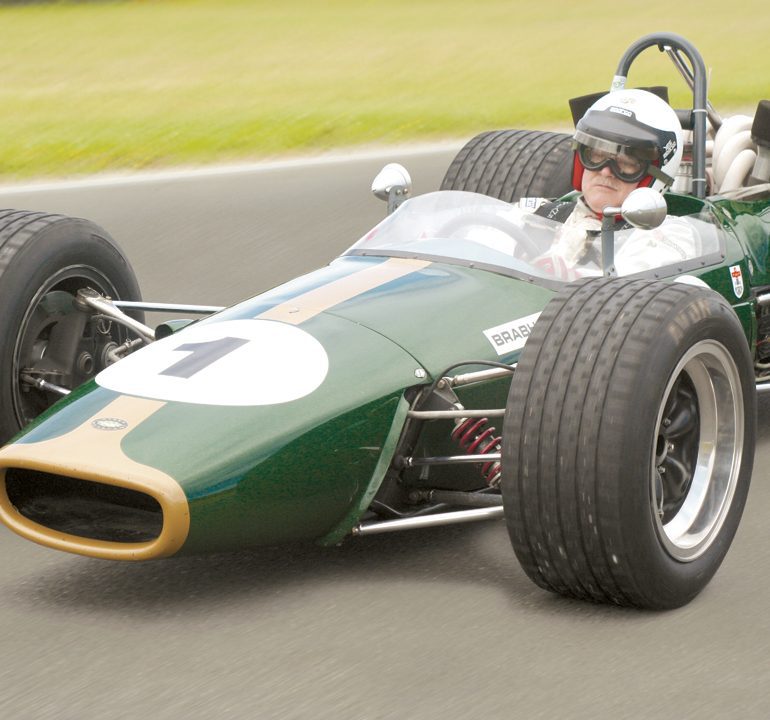1967 Brabham BT24-Repco
Sometimes all your birthdays and Christmases come at once.
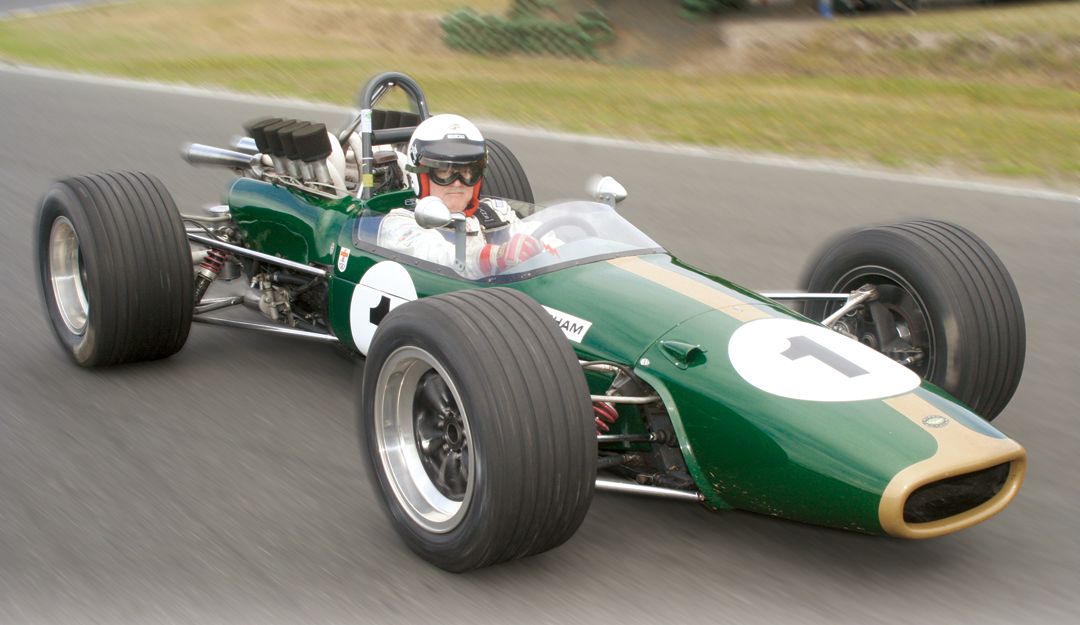
Photo: Casey Annis
Picture the scene: It is February 2006 and the Vintage Racecar team has gathered at the famous Phillip Island circuit south of Melbourne for one of the best historic racing festivals to be found. As you look south, the sea shimmers forever and the next stop is Antarctica. The organizers have pulled out the stops so we could do a photo shoot with two famous cars, Dan Gurney’s Eagle-Weslake and the BT24 that Jack Brabham used as his car for most of 1967.
I had been working on…and still am…a project that will end up as a book in which we test all the 1967 Grand Prix cars. If it meant going all the way to Australia to do it, that wasn’t such a great hardship! VR readers will already know what a great thrill it was to get behind the wheel of the Eagle…a truly magical car. When it came time to sample the BT24, I was advised that I was now going to be the “lunch-time” entertainment. Car owner Brian Wilson stood by, not looking too nervous over the prospect of his treasure being driven by someone he didn’t know.
Sitting in the cockpit, totally aware that I was in a significant Brabham car in Brabham country, there was suddenly a knock on my helmet. As Australian a voice as you ever heard boomed to the owner: “You aren’t going to let him drive this are you, mate?” followed by a roar of laughter. There stood the triple World Champion himself. Jack then gave some stern advice: “Don’t break it, mate…I never did and they are very hard to fix!”
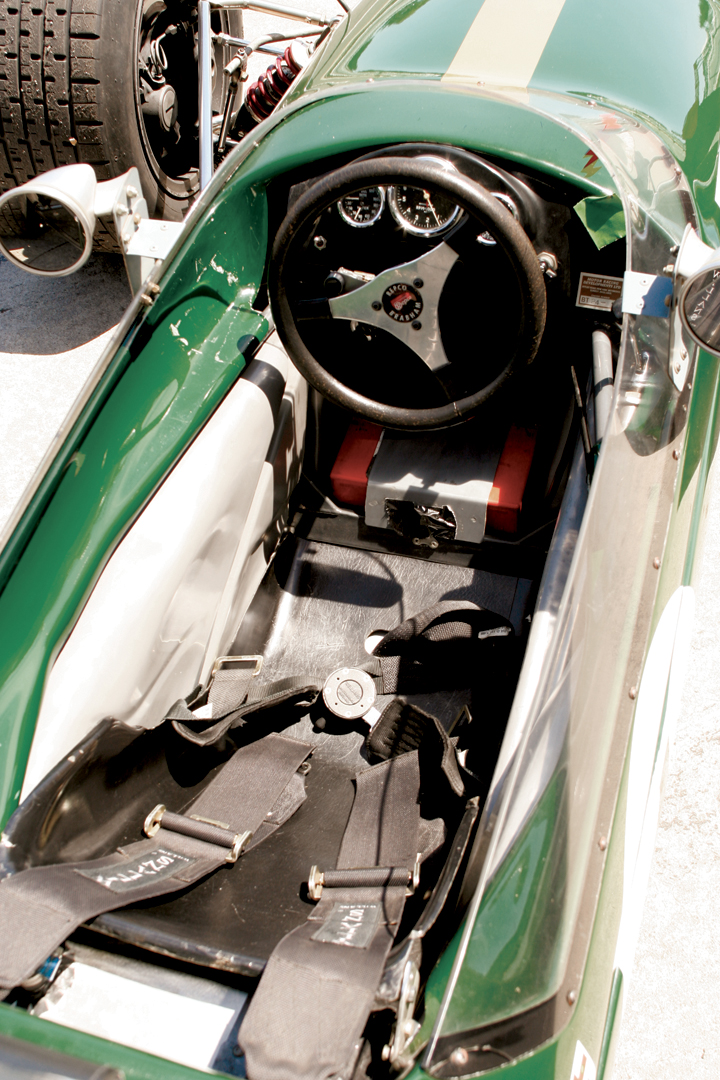
Photo: Casey Annis
Brabhams in F1
Grand Prix races had been run to a number of formulae over a period of many years. From 1954 to 1960 unsupercharged engines were restricted to 2.5-liters and supercharged cars had only 750-cc to play with…not many went that route. The rules changed in 1961 when the size shrank to 1.5-liters, which was generally unpopular. This was to run through 1963, but was then extended to the end of 1965, and the 1.5-liter cars were quick indeed. When meetings were held in 1963 to decide on future rules, the drivers and the GPDA favored a 2-liter limit that would allow most of the 1.5 engines to be enlarged. However, a 3-liter limit was approved, much to the delight of Ferrari who already had such a unit, and the new rules would come into effect in 1966. Supercharging of 1.5-liter engines was allowed, but that was not a popular avenue at all. During 1964 and 1965, rumors were rife about what team would be using what engine. Gurney was thought to be trying to get a development of the Coventry Climax unit from an American block; BRM were working on several fronts…V-12 and H-16; Lotus had the Ford 4.7 in the Lotus 30 and were known to be talking to Ford about a 3-liter engine. There was a possibility of an Alfa Romeo 3-liter, and from Australia came guesses that Brabham would work with their backer, Repco, to develop something.
Jack Brabham, of course, was very well known long before the 3-liter formula had come along. He had first appeared in the 1955 British Grand Prix at Aintree in a Cooper-Bristol, and was in the same race the following year at Silverstone in a Maserati 250F. Then came the stunning 6th-place at Monaco in 1957 in the Cooper T43, and a 7th at Rouen sharing with Mike MacDowel. Moss, Trintignant, and Salvadori got most of the Cooper glory in 1958, but the front-engine teams still didn’t take it too seriously. It wasn’t until 1959 when Jack got two wins and a 2nd and a 3rd in the first four races that the writing began to appear on the wall. He went on to take the championship by four points from Tony Brooks, and in 1959 his run of five straight wins saw him do it again. This time he won by nine points from young teammate Bruce McLaren. They had put Cooper on top of the F1 world.
There were no wins for Jack in Ferrari’s dominant year in 1961—with 1.5-liter cars—though Jack went to Indianapolis and took the rear-engine revolution with him, coming 9th in a tiny Cooper. Again, Jack Brabham was found guilty of writing on the wall!
Brabham could see that Cooper was not going to remain competitive so he had a private Lotus 24 for the early races of 1962, while he was hatching other plans. He had formed a company called Motor Racing Developments with fellow Australian Ron Tauranac, and in 1961-’62, they were producing production Formula Junior cars. They had known each other in Australia and had both obtained parts for cars from the Replacements Parts Pty Ltd, a company run by Geoffrey Russell, which shortened its name to…Repco. Repco played a major part in the business of MRD and also in BRO—the Brabham Racing Organisation—which Jack set up separately to run the F1 race team. MRD designed and built the first Brabham F1 car, the BT3, and it was entered for Jack at the German Grand Prix with a 1.5 Climax engine.
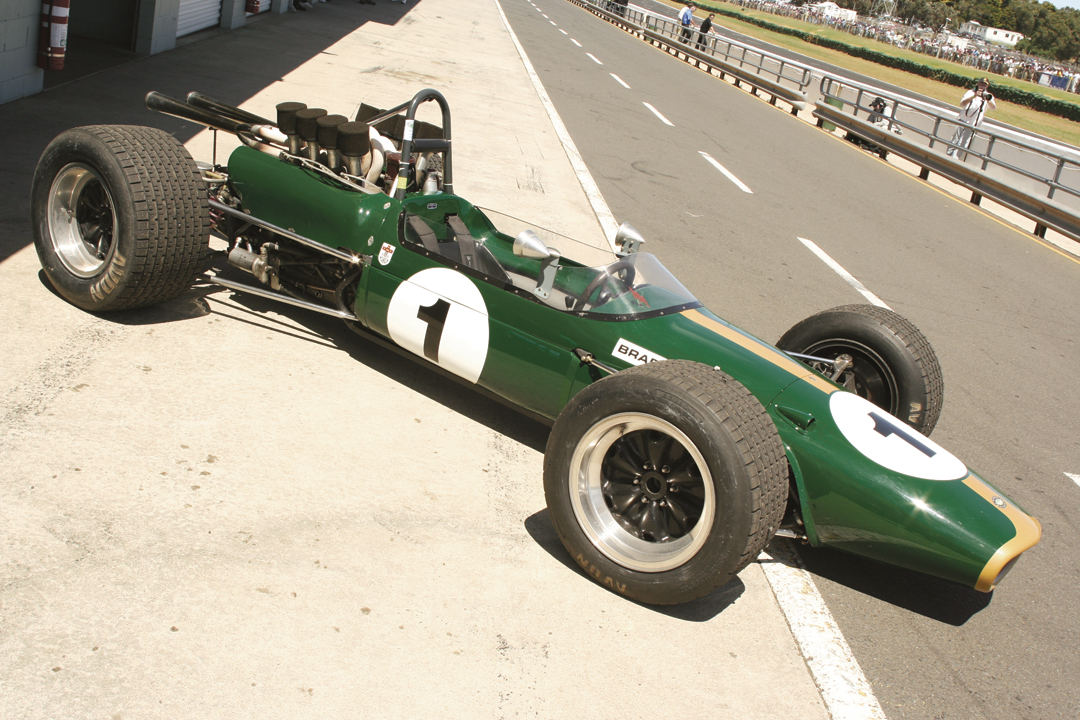
Photo: Casey Annis
The BT3 retired at the Nürburgring with a broken throttle linkage, but it reappeared to take an impressive 4th place at Watkins Glen, a result that was repeated in South Africa. Jack Brabham had made his debut in a car with his own name on it in Grand Prix racing and scored nine Championship points.
As 1963 began and the 1.5-liter formula continued, Dan Gurney joined the team and drove a new BT7-Climax, while Jack began with the BT3 until his BT7 was ready. The BT11 appeared in 1964 as a customer car, and variants were used at Indianapolis and in the Tasman series as well. Then Gurney gave Brabham its famous first win at Rouen, still in the BT7, with Jack 3rd. By this time, the BT11 contingent consisted of Jochen Rindt, Jo Siffert, Jo Bonnier, and Bob Anderson, and they were all doing well. Gurney had another win in Mexico, and Brabham finished 4th in the constructors’ table. The BT11 was the mainstay of both works and private Brabham teams for 1965, but no wins were recorded.
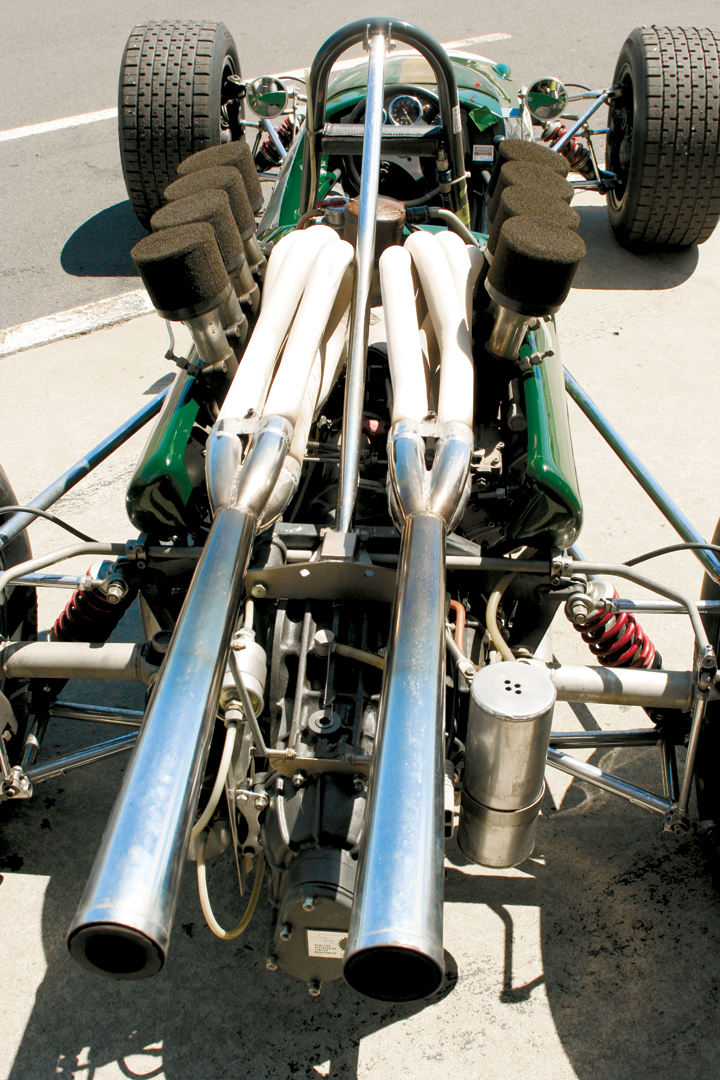
Photo: Casey Annis
The Repco Engine
For several years, to demonstrate how important Repco was to the Brabham operation, the Repco name appeared on many cars—the Junior was the Repco Brabham Ford, and the first Tasman cars were the Repco Brabham Climax. The involvement of Repco in what would become the 3-liter engine for 1966 started back early in 1964. It was realized that Climax engines would be running out and that Climax would not stay in production for a lot longer. Climax had promised a flat 16-cylinder 1500-cc engine, but this never materialized. This was a disappointment to MRD as a chassis had already been built to accept it. This chassis would become the BT19 that would be adapted to take a much different product.
Phil Irving and Frank Hallam at Repco were authorized to start work on a new engine to fit into this chassis. Aware that General Motors had put a great deal of work into trying to produce a 3-liter alloy, liner-less unit for a proposed compact Buick, Repco picked up the “bits” from this failed project. The block had originally come from the Oldsmobile F85. Rather than attempt to expand a much smaller existing engine, this off-the-shelf unit had the advantage of accommodating displacement from 2.5 to 4.4 liters, and therefore could be used in a number of ways. The project proceeded with the knowledge that there was an existing chassis for the car to go in, so that determined the width and height of the engine. The new design used a simple, straightforward head that was common to each bank of cylinders. This was done with practicality and cost very much in mind. The Repco expertise meant the prototype engine appeared just less than a year from the time the design work started. This engine was to Tasman specs, a 2.5-liter unit. The bench testing was very promising, and Phil Irving returned to England with Jack to work on the details of the 3-liter engine for 1966.

Photo: Casey Annis
The design incorporated a bore and stroke of 88.8 x 60.3 mm, which produced a displacement of 2,994-cc. Although this was a short-stroke engine, it produced maximum power at only 8,000 rpm with Lucas fuel injection. What was to become the Repco Type 620 engine was a medium-fast circuit unit, important in that most of the Grand Prix races were on that type of track, as were numerous non-championship rounds that paid lucrative start and prize money.
Though the intention had been for a brand-new chassis to be built for the new engine, time ran out and the first engine went into the BT19 chassis which had been intended for the Climax Flat-16. The 620 was lighter than much of the opposition, and it had good fuel consumption. It soon developed 311 bhp at 7,400 rpm.
The 1966 South African Grand Prix at East London was a nonchampionship event, but important in that it marked the “return to power” with 3-liter engine rules now in place. Jack Brabham stuck the BT19-Repco on pole from Mike Spence in a Lotus 33-Climax and the second works Brabham of Denny Hulme, a BT11-Climax. Brabham ran very well but the new car expired with just ten laps left when the fuel pump failed. Jack took the car to Syracuse for another non-championship race in early May, but struggled in practice and had the metering unit fail on the first lap.
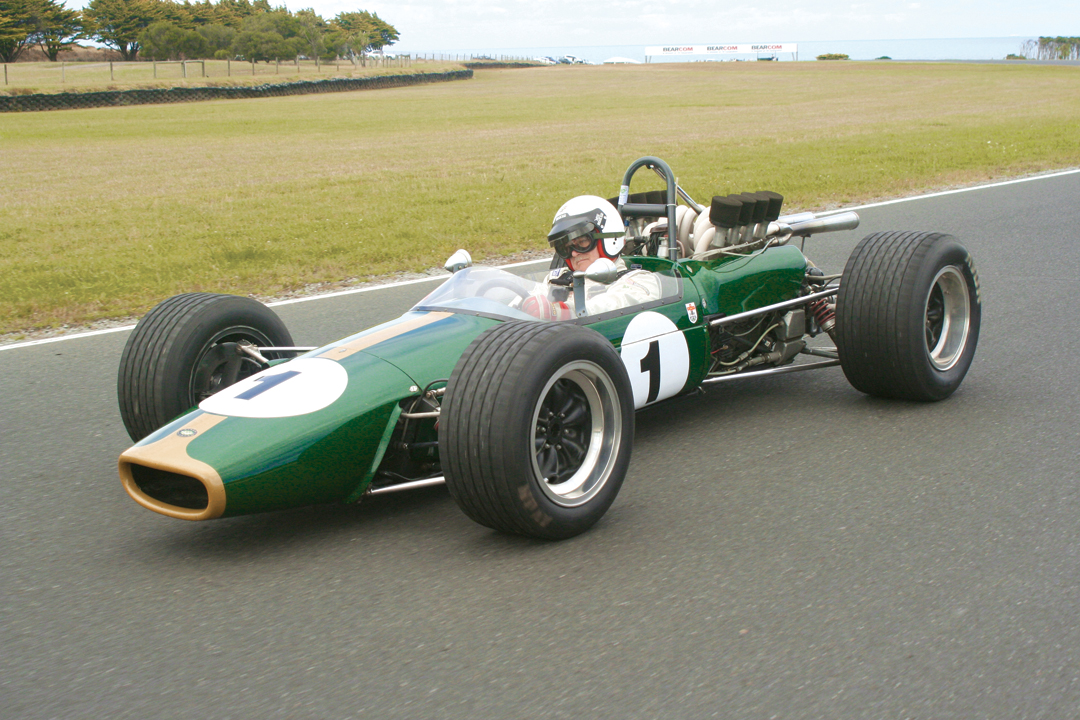
At Monaco, gearbox problems stopped the car after 17 laps, but then Jack managed 4th at Spa. Then the amazing French Grand Prix at Reims—not a Repco circuit—took place and Jack became the first person to win a Grand Prix in a car of his own making. Denny Hulme followed in 3rd behind Parkes’s Ferrari, in the new BT20-Repco. The tide had turned.
Jack and Denny were 1st and 2nd in Britain; Jack won in Holland and Denny retired; Jack won at The Ring and Hulme retired again; and at Monza, Hulme ran 3rd but Jack retired with an oil leak. Both cars retired at Watkins Glen—where I was on hand to see them—as Jim Clark won in the Lotus 43 with the BRM H-16 engine. Jack and Denny then finished 2nd and 3rd in Mexico City. That gave Jack Brabham his third title by a large margin from John Surtees, with Hulme 4th. Brabham-Repco won the constructors’ championship by 11 points from Ferrari, which is interesting in light of the fact that the raw, unmachined, F85 alloy blocks had cost only 11 pounds sterling each!
The BT24
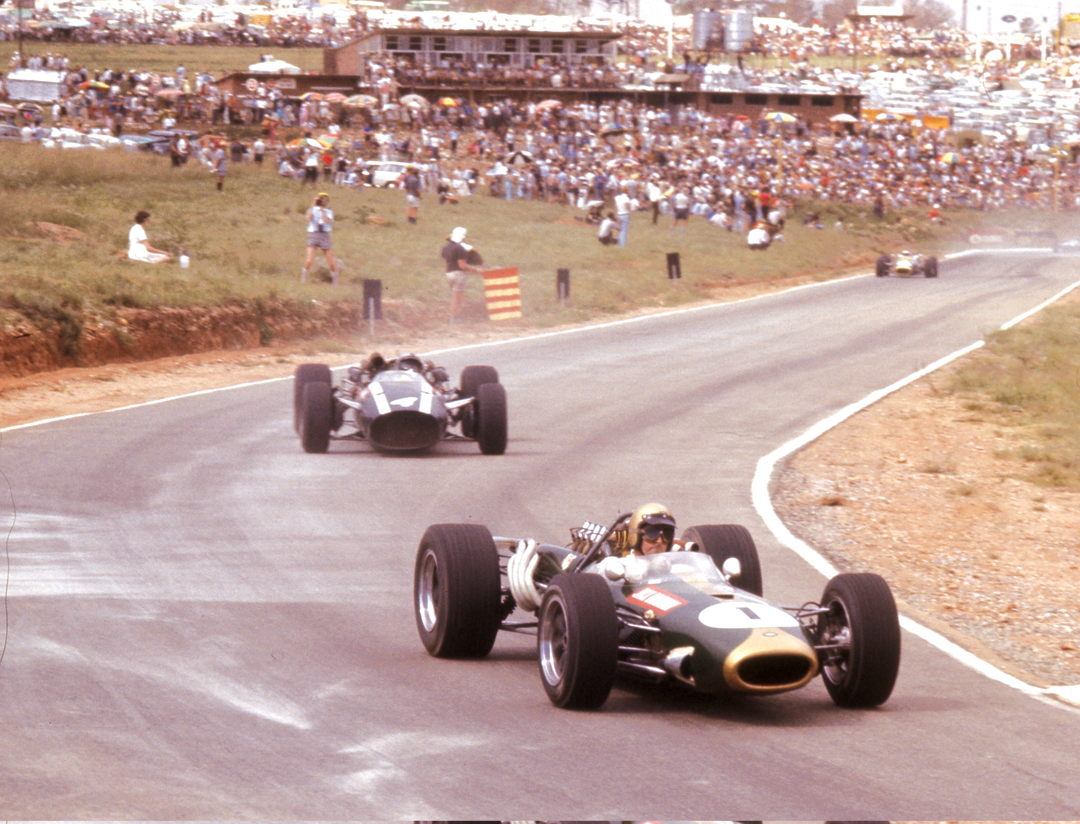
Photo: Ed McDonough Collection
The BT19 chassis gets somewhat lost in the story of Repco’s rise from nowhere to World Championship, but it was a very important part of the story. The multi-tubular space frame was a one-off, built for the Climax engine, and only one chassis was built by Tauranac, in the face of a move toward stressed-skin monocoque designs. It was, however, all part of the MRD philosophy of simple designs that were manageable for paying customers. Tauranac’s use of oval tubing around the cockpit area made the chassis considerably stiffer, and a great deal of work had also gone into stiffening the Repco engine. The BT19 with the Repco on board started off with a Hewland HD 5-speed transaxle, and Jack had to make easy starts to save the box. However, Hewland then developed the DG model that, in Mike Hewland’s words, stood for “different gearbox”!
Once the 1966 season was under way, work began on a proper chassis, and the BT20 was very much a revised and improved version of the BT19. Suspension geometry was revised: there were bigger brakes, and they ran on 15-inch wheels all around. In mechanical terms, the two models were identical. These would nevertheless all be interim cars, as the team knew they would have to improve for 1967 since all the other teams were coming up with many innovations. Early in 1967, a new BT23A F2 car was fitted with a Tasman-spec Repco engine. This car had specially cast front uprights and a re-worked engine bay. The BT23A was a minimalist design, as Tauranac said, “Just enough car to do the job.” They were so happy with it that plans were made to produce three chassis for Formula 1…the BT24.
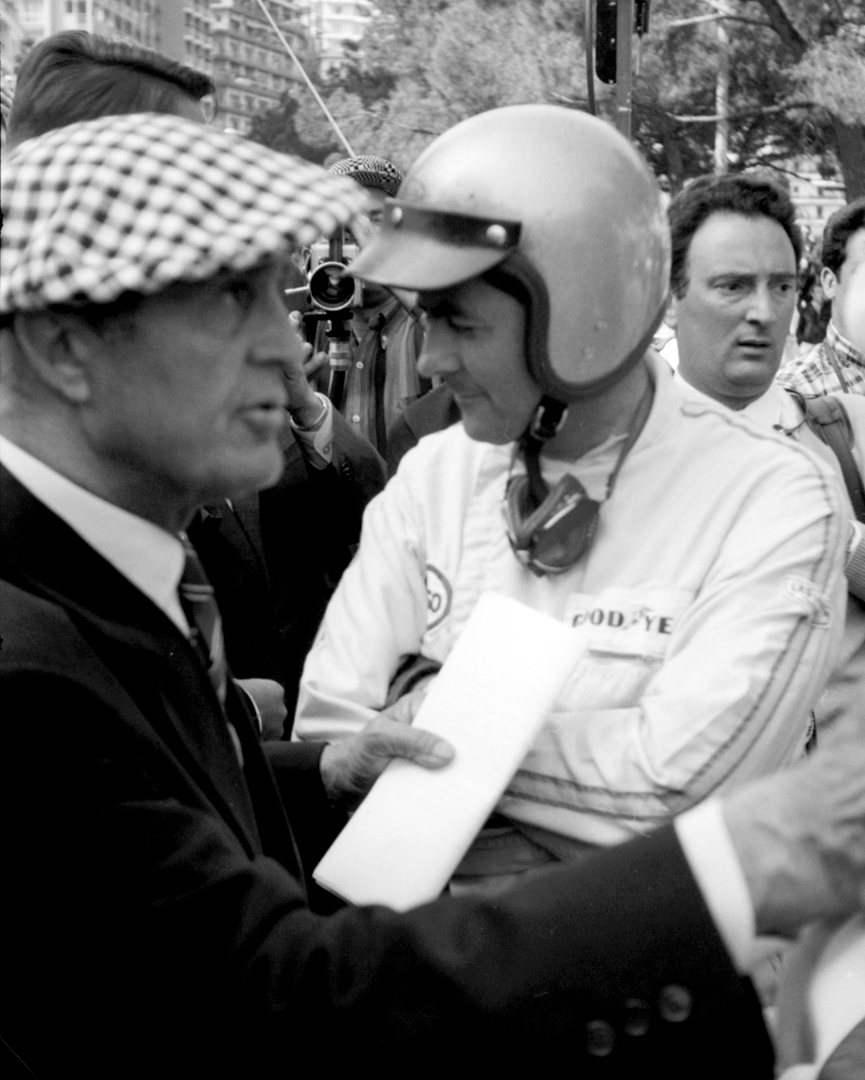
Photo: Ed McDonough Collection
Racing the BT24s
The BT24 had a relatively long chassis, with a narrow front track compared to the BT19 and BT20, though the rear track was equally wider. The nose cone was now removable, the body was very tidy, and the suspension remained similar to the earlier cars except for the new front uprights. In brief testing the cars appeared to handle well, and both drivers considered them to be very forgiving. The car you see here, BT24/01, was the car Jack used for most of the 1967 season. The team appeared in South Africa with the two BT20s, and Denny won at Monaco with the BT20, after Jack had his engine fail virtually at the start. Then they took 01 to the Dutch Grand Prix and tried it with a lighter F2 gearbox to see if they could save even more weight. After deciding not to race it, Jack took 2nd in the original BT19, while Denny was 3rd in the BT20. The race was won by one Jim Clark in a new Lotus 49 with a Ford Cosworth engine.
I don’t want to sidetrack here, but for many people, 1967 was a very special year in Grand Prix racing. Don’t take my word for it, just look up “1967 Grand Prix” on Ebay, and check out the talk on many forums. For a number of reasons, it is almost an iconic period. Part of that is because the drivers were great: Clark, Brabham, Surtees, Hill, Hulme, Bandini, Amon, Rodriguez, Gurney, Courage, Siffert, Rindt, Stewart, Servoz-Gavin, Ginther, McLaren, Spence, Beltoise…! And the cars were new and exciting: Lotus 49, BRM T83 and H-16, Ferrari 312, Eagle-Weslake and the Brabham. And sponsorship had not yet transformed the scene. It was old world and new world coming together. It was a very special time.
Well, Clark had shaken things up at Zandvoort all right, but Gurney really rattled the cage at Spa. Ah, Spa…the old circuit, no chicanes. Jack Brabham brought the new BT 24/01 to Spa and it ran well from 7th on the grid but the engine failed, so it was a disappointing debut. Hulme in the BT19 made one lap less than Jack.
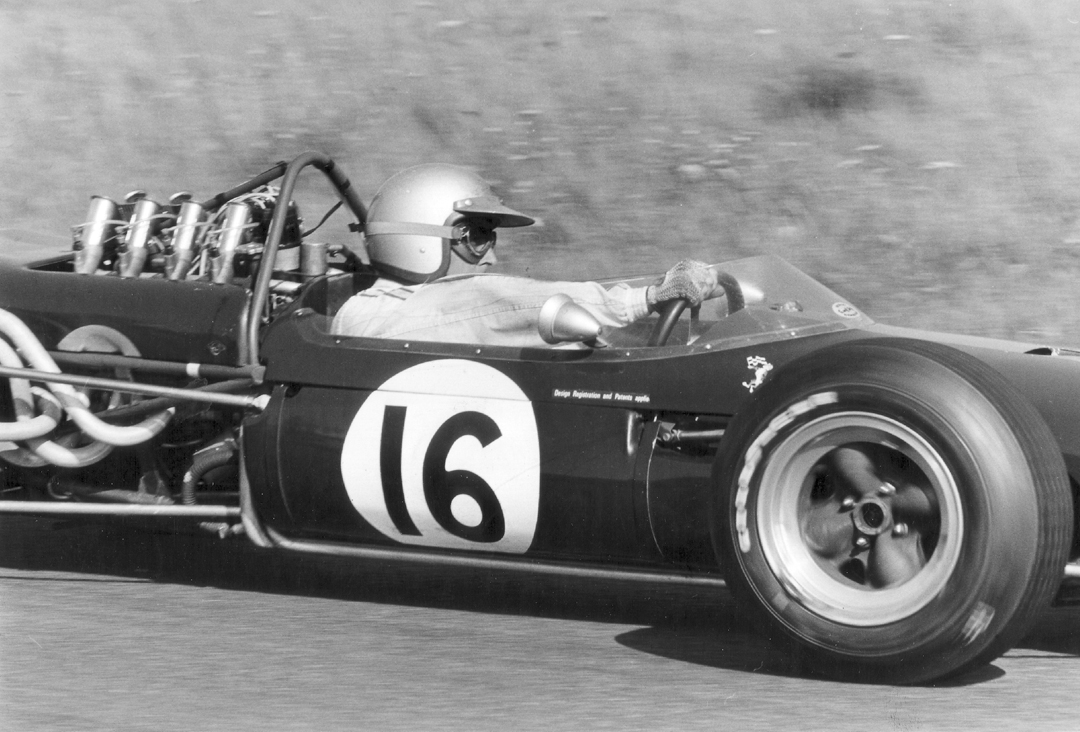
Photo: F1 Photo
Then came a trip to Le Mans, not to the 24 Hour circuit but the rather more tame Bugatti track. Both new BT24s were there, Jack in 01 and Denny in 02, and they were 2nd and 6th fastest in practice. The low-down torque was working well, and Clark dropped out, but he couldn’t challenge the new Brabham Repcos anyway. Jack was 1st, Denny 2nd, a lap clear of Jackie Stewart. The Brabham train was rolling on. Clark then sent the British fans wild by winning at Silverstone with Denny not far behind and Jack in 4th, behind the much-admired Chris Amon. These were very popular guys, and the fans loved them and the races they contested that season.
At the Nürburgring, the torque worked again, and Hulme took a great win from Jack with Amon 3rd again. The Brabhams were 2 feet in the air over Brunnchen and some of the other corners, and yet they put up with the pounding magnificently. The positions were reversed at Mosport in Canada, Jack winning in 01 and Denny next in 02. Surtees showed at Monza why that season is well remembered. He had been very critical of the Honda RA273 and put a face-threatening proposal to the Japanese Honda bosses: Save weight or lose. Mr. Honda agreed to a Lola-built chassis and, in a few months from conception, Surtees took the RA300 to its debut win at Monza—a mere 2/10ths ahead of Jack in 01.
Clark and Hill dominated at Watkins Glen, with Hulme 3rd and Brabham 5th. Then there was the season-ending battle between Clark, Brabham, and Hulme in Mexico City—a bit of new tech versus old tech. The Lotus 49 had huge potential, but the early Cosworth DFV had a very narrow power band and the power came in with a wallop. The chassis was very sophisticated, although not easy to drive, but everyone knew they were seeing the future. Jack finished 2nd behind Jimmy and Hulme was 3rd. Although Clark had led more laps during the season, Denny Hulme took Brabham’s second championship, with Jack himself 2nd by five points, ahead of Clark and Surtees. Jack was only 4th among the lap leaders, but he was almost always there at the end.
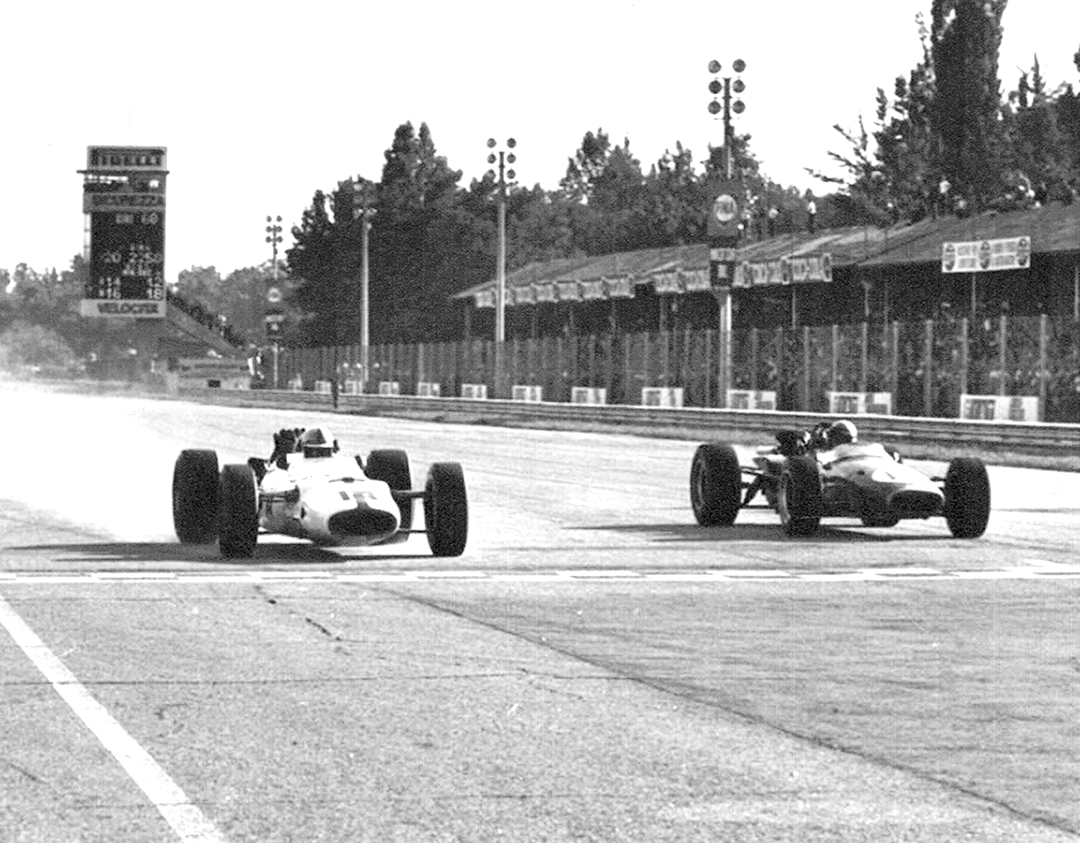
Chassis BT24/01
Jack Brabham had raced this car nine times in 1967, and raced it only once more, retiring at the 1968 South African Grand Prix. Basil van Rooyen then raced 01 through 1968 on nine occasions. Gordon Henderson took it over for all of 1969 and part of 1970 before selling it to Ivor Robertson, who only managed to get it into one race at Killarney where it retired. Van Rooyen had had two wins, but nobody was as successful as Jack had been. The car remained unraced for 30 years before it came into the hands of Australian Brian Wilson, who restarted its racing career in 2000, reunited it with Jack, and has since taken it around the world.
Hulme raced 02 seven times in 1967, Rindt was 3rd in South Africa in 1968, and then Sam Tingle took it over, raced it through 1970 and still has it in his home. Chassis 03 didn’t appear until May of 1968, and was driven by Rindt twice, Gurney once, and Kurt Ahrens once. It then became a 2.5 Cosworth Tasman car for Piers Courage, who did seven races. It was sold to Silvio Moser in May 1969, and he did five events. That car was dismantled by his mechanic Beat Schenker and now belongs to Moser’s widow in Switzerland, who is putting it back together—I have been to visit it! It is not to be confused with the replica, which was in America and is now back in the UK.
Driving Jack’s Car
At the beginning I made it clear that getting to see this car was special enough, getting to drive it spectacular, and having Sir Jack Brabham on hand to oversee the event…well, what can you say?
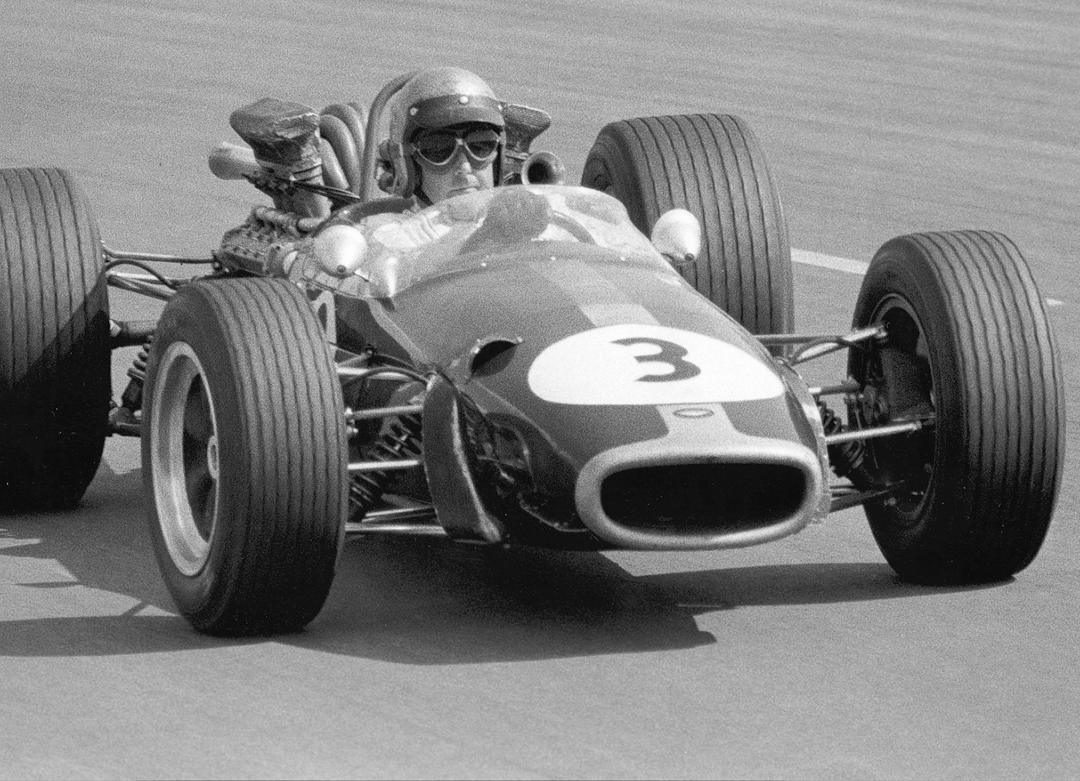
Photo: F1 Photo
I had never even been remotely near a Repco engine except that, prior just to Phillip Island, we did every car collection within a 100 miles of Sydney and saw quite a few in various states…including some quite special, and still to be revealed, Jack Brabham machines.
However, sliding down into Brian Wilson’s 01 was very special. When I got over Jack’s presence and teasing, I was able to get back to concentrating on the car. Somewhat to my surprise, the Repco engine was quite docile, not fluffing and stalling in the pit lane in front of Jack and thousands of others. I expected the 5-speed box to be tricky, but again it was not only easy but robust, with a lot of feel to it. I recalled how tricky I had found managing the Lotus 49, but this was easy by comparison. That was just as well, as we had to do some slow lappery behind a camera car before getting a chance to really try the car.
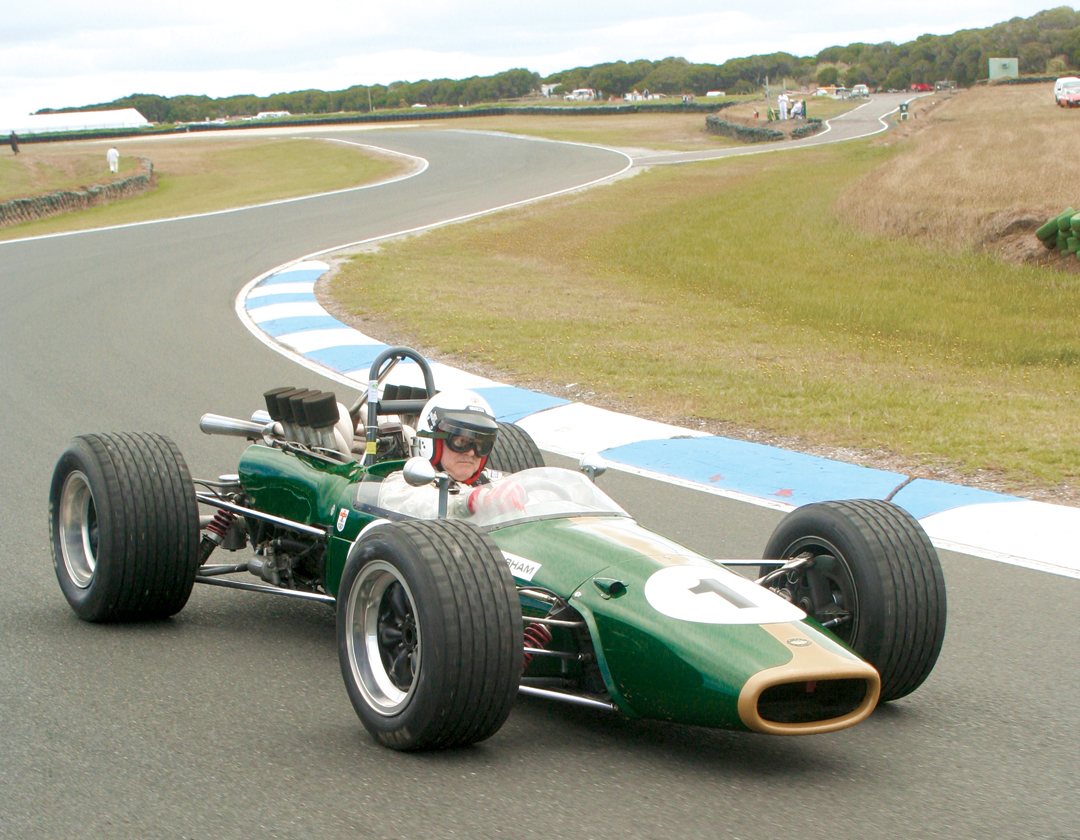
The Phillip Island circuit is fast, swooping, and has a lot of challenging and off-camber corners. History had shown how much low-down power was available from the Repco engine, and indeed the torque was very impressive. The interesting thing about the car is that it is quite small, and you do sit upright in it, sticking out in the airstream. This means your upper body experiences a lot of motion in the sweeps at Phillip Island. You rush down into tight corners going through the gearbox without looking at it, dabbing at the brakes, and keeping your eyes peeled for the apex. In spite of sitting fairly high in the car, the handling is so good that it is not at all uncomfortable.
Jack was proud of the development work he had done on the brakes, and promised me they would be good. True to his word, they not only worked effectively, but were amazingly smooth. Though there was no other traffic on the circuit while I was out there, I automatically checked the mirrors. That was a reflex action, but I also remembered that they had fallen off this car when Jack raced it at Silverstone, earning him a reprimanded for baulking Chris Amon.
The outstanding driving memory is of the car’s quintessential lightness. The Lotus 49 was light but skittish. The BT24 is light but has feel, and doesn’t do anything stupid. Somehow I expected the Repco engine to make it tail heavy, but that was my mistake. This is a memorable and totally well-behaved machine. Thanks Brian, thanks Jack, thanks Ron.
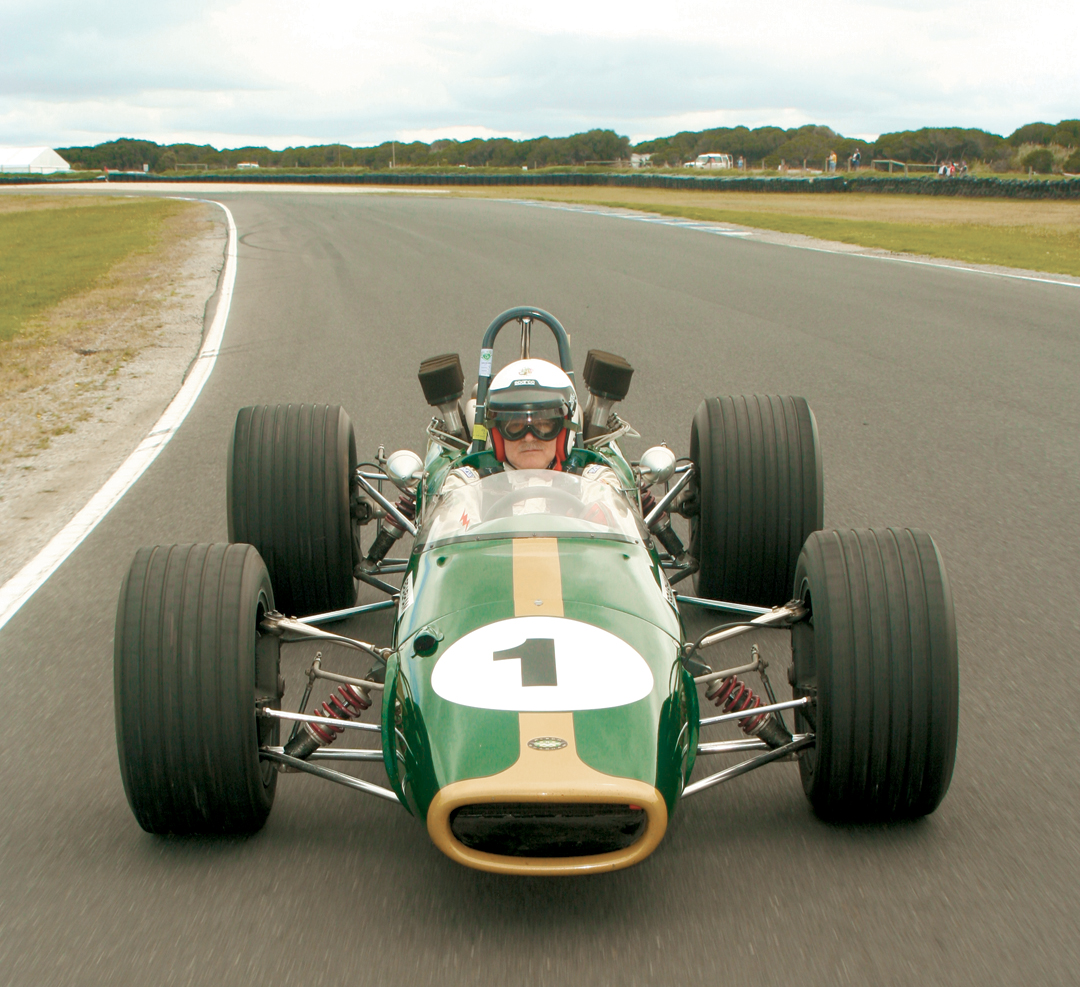
Specifications
Chassis: Steel tubular space frame; mild tube steel, using oval and square tube
Chassis Weight: 70-lbs
Total Weight: 1,140-lbs
Suspension: Front: double wishbone, outboard spring/damper Rear: single top-link, reverse lower wishbone, twin radius arms, outboard spring/damper
Engine: Repco V-8 normally aspirated
Displacement: 2,994-cc
Bore and Stroke: 88.8 x 60.3mm
Gearbox: Hewland DG, 5-speed manual with ZF differential
Brakes: Steel Girling discs, Ferodo pads, front and rear mounted outboard
Wheels/Tires (In Period): Front: 6-stud Brabham cast aluminum; 8 x 15, 10.95” wide. Rear: 6-stud Brabham cast aluminum; 12 x 15, 13.10” wide
Resources
Very many thanks to Brian Wilson for allowing us to test this great car, to Sir Jack for being there and giving advice and friendship, and to Ian Tate and the officials at Phillip Island who made it possible.
Brabham, J. The Jack Brabham Story. Pavilion, London, 2004.
Nye, D. The History of the Grand Prix Car 1966-91. Hazleton Publishing, Surrey UK, 1992.


